On any given day, a lineup of gleaming cruise ships towers over the docks at PortMiami. Inside the terminals, thousands of excited passengers bustle through check-in, their energy and anticipation adding to the city’s buzz. This bustling seaport scene underscores how integral cruise tourism is to Miami’s growth and identity. In fact, Miami has earned a global reputation as the “Cruise Capital of the World” , a title reflecting the city’s unparalleled cruise traffic and its prominence in the industry.
The cruise sector’s rise has not only brought millions of visitors to Miami’s shores, but also helped shape the local economy, sparked debates on sustainability, and cemented Miami’s image on the world stage.
Jump to: Cruise Capital • Global Rankings • Economic Impact • Sustainability Efforts • Global Image • FAQ
TL;DR - Miami Cruise Tourism
- PortMiami = “Cruise Capital of the World” with 8.23M passengers in 2024
- 10 cruise terminals including new mega-terminal expansions
- $61B+ annual economic impact, 340,000+ jobs supported in South Florida
- Environmental debates: emissions, waste, but new sustainability measures like shore power in 2024
- Cruises now central to Miami’s global image and tourism identity
More on Miami:
The Cruise Capital of the World
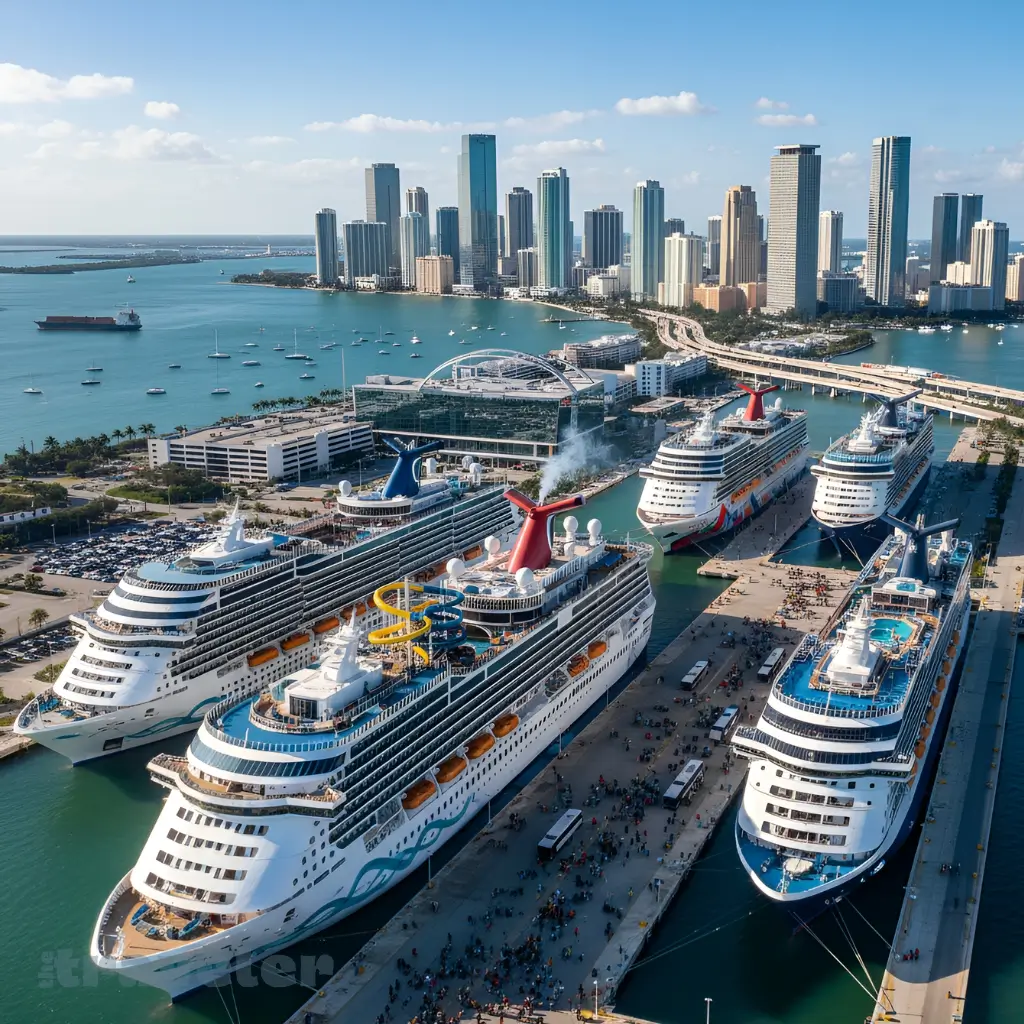
Miami’s claim as the Cruise Capital of the World is more than just a catchy tagline – it’s backed by record-breaking numbers. PortMiami handles more cruise passengers than any other port on the planet. Virtually all the major cruise lines operate here, and several have headquarters or primary homeports in the city. Carnival Corporation, Royal Caribbean International, and Norwegian Cruise Line are among the industry giants with deep roots in Miami.
This concentration of cruise companies and ships has made Miami a one-stop hub for cruise vacations, especially for voyages to the Caribbean and Americas. Peak winter weekends see the port teeming with mega-liners, each bound for tropical destinations – a testament to Miami’s dominant role in the cruise world.
Maintaining the “Cruise Capital” status has meant continuous growth and investment at PortMiami. Over the decades, the port expanded to accommodate an ever-increasing fleet of ships. As of 2025, PortMiami boasts ten modern cruise terminals, including a brand-new 492,000-square-foot terminal opened in 2025 that can serve up to 36,000 passengers in a single day.
These state-of-the-art terminals, some designed for specific cruise brands, allow Miami to berth the industry’s newest and largest vessels. The port’s capacity and efficiency keep improving – ensuring that Miami remains the embarkation point of choice for cruise travelers. From the iconic Royal Caribbean “Crown of Miami” Terminal A to MSC Cruises’ sprawling new Terminal AA, the infrastructure underscores Miami’s commitment to staying on top. This physical growth of the port has both enabled and been driven by an extraordinary surge in cruise passenger traffic.
Record-Breaking Passenger Numbers and Global Rankings
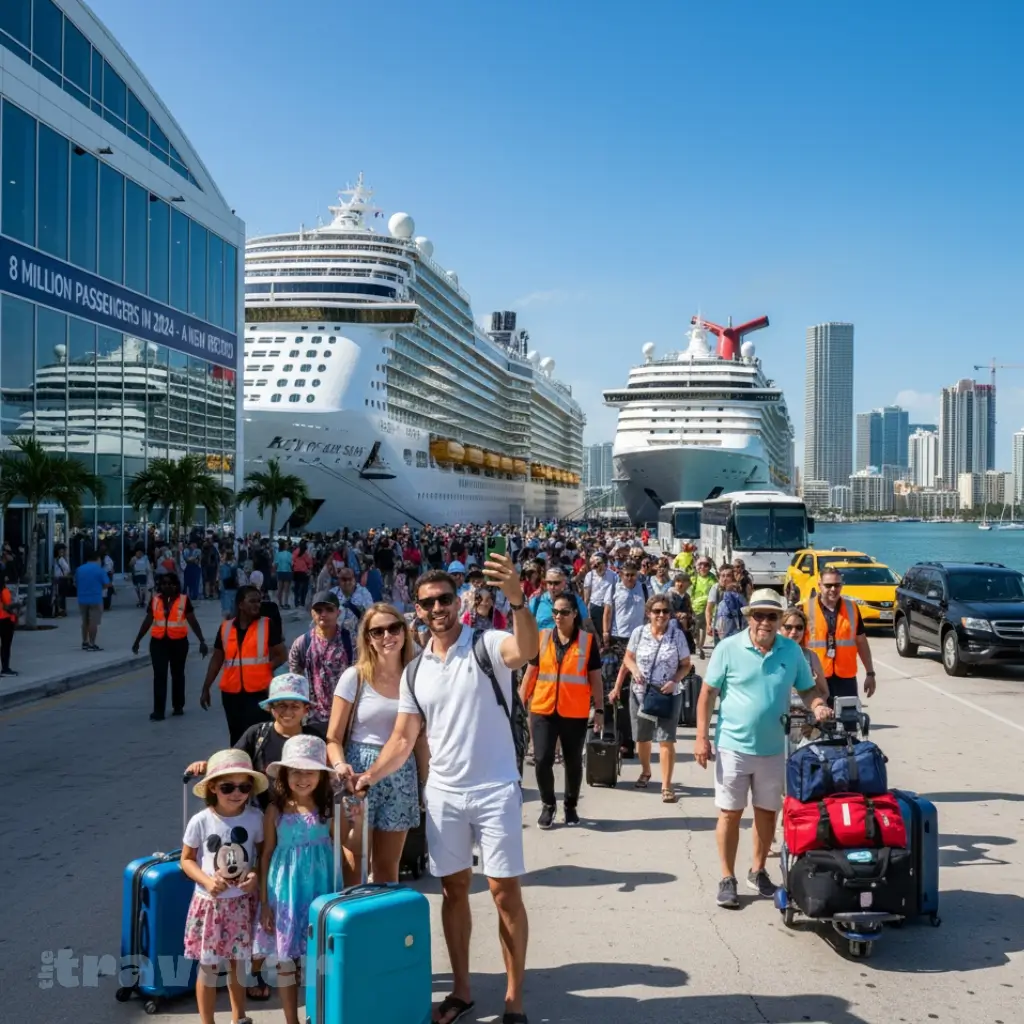
PortMiami’s passenger traffic in recent years has smashed all previous records, further solidifying Miami’s top rank globally. In the 2024 fiscal year alone, 8.23 million cruise passengers passed through PortMiami’s terminals – the highest annual total ever recorded.
This figure marked a 12.8% jump over the prior fiscal year’s tally of about 7.3 million, which itself had been a record at the time. Such growth underscores the robust recovery and expansion of cruising in Miami, only a few years after a pandemic-induced pause. Miami comfortably maintains its No. 1 spot as the world’s busiest cruise port, outpacing all competitors.
Even Florida’s second-busiest port, Port Canaveral, saw roughly 7.6 million cruise guests in 2024 – a impressive number but still below Miami’s volume. Other major cruise hubs like Port Everglades in Fort Lauderdale (about 4.0 million passengers in 2024) and global ports such as those in Europe or Asia don’t come close to Miami’s throughput. These rankings confirm that when it comes to cruise tourism, Miami is in a league of its own.
The sheer scale of Miami’s cruise operations is evident not just in annual statistics, but in daily activity. On a busy day, tens of thousands of travelers might embark or disembark in Miami, filling hotels the night before and flooding into the port in waves. Cruise ships from every leading cruise line call Miami home throughout the year.
During peak season, one can witness up to half a dozen large cruise vessels lined up at once, from luxury liners to the world’s largest cruise ships. (Notably, Miami is the homeport of Royal Caribbean’s Icon of the Seas, the biggest cruise ship on the planet by gross tonnage.) This extraordinary passenger traffic has not only earned Miami bragging rights, but also fueled broader economic growth as travelers from around the globe begin and end their journeys in the city.
Economic Impact: Jobs, Businesses, and Urban Growth
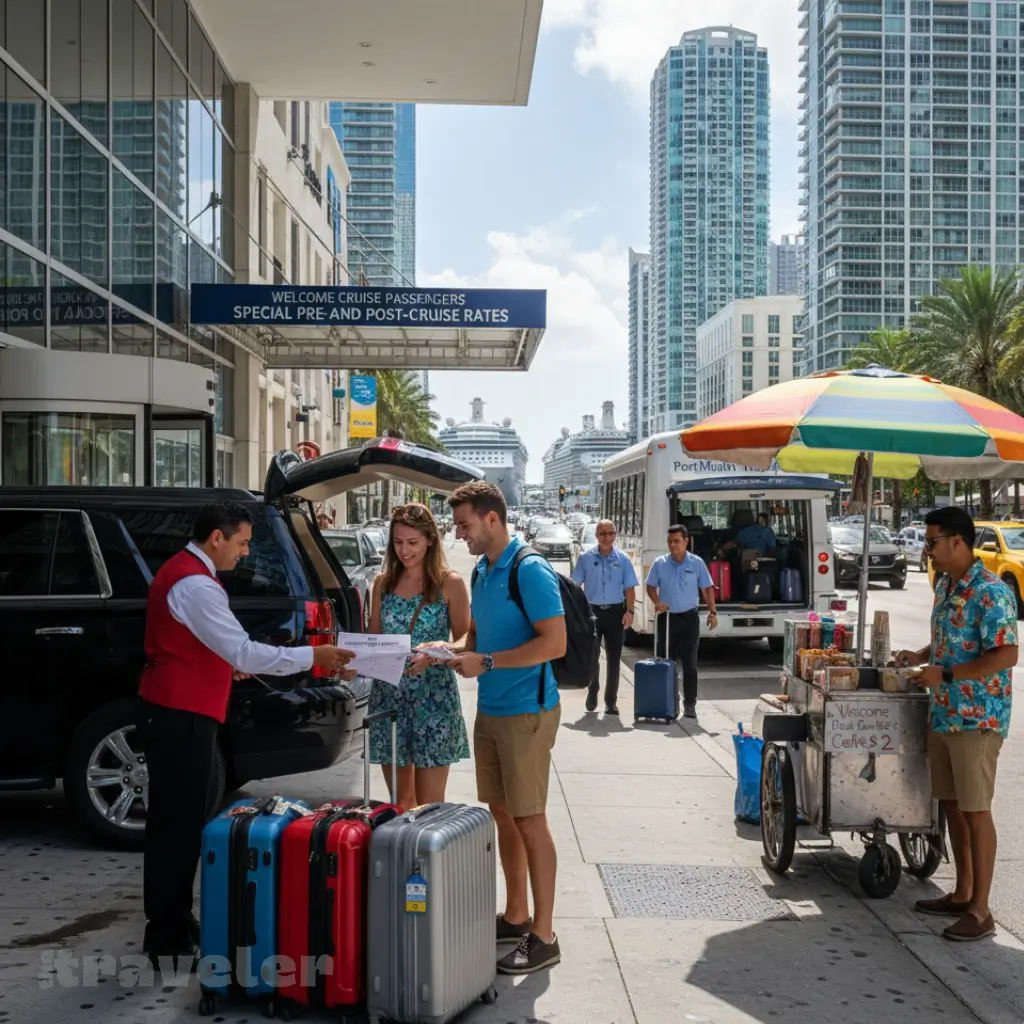
Cruise tourism’s contribution to Miami’s economy has been enormous, acting as a key engine of growth for the region. PortMiami today stands as one of Miami-Dade County’s largest economic drivers, contributing an estimated $61 billion annually to the local economy and supporting over 340,000 jobs in South Florida.
This figure includes the combined impacts of cruise and cargo operations, but the cruise sector alone forms a considerable share of that prosperity. Industry studies have found that the cruise industry supports more than 200,000 jobs in Florida and generates roughly $9.7 billion in economic activity in the state.
Many of these jobs are concentrated in Greater Miami – from port staff, longshoremen, and cruise line corporate employees to the vast network of suppliers provisioning ships with food and goods. Beyond direct employment, there’s a ripple effect: local tour operators, transportation services, and suppliers all benefit from the steady flow of cruise ships and passengers.
One of the most visible impacts of cruise tourism is on Miami’s hospitality and service sectors. Hundreds of thousands of cruise passengers don’t just pass through – they often spend extra time (and money) in the city. Many travelers choose to arrive in Miami a day or two before their cruise or linger after disembarkation to turn their voyage into a longer vacation.
They fill up hotels, dine at local restaurants, visit attractions, and shop in local stores. According to Miami’s tourism bureau, nearly all of those millions of cruise guests represent potential visitors to the city itself – many choose to enhance their cruise by spending additional days pre- or post-voyage in Greater Miami, enjoying everything from beaches and Everglades tours to the city’s vibrant food scene.
This pre- and post-cruise tourism translates into significant revenue for hotels and eateries across Miami. In essence, cruise ships act as a massive funnel of visitors into the city, helping keep hotel occupancy rates high and filling tables at restaurants year-round.
The cruise boom has also spurred infrastructure investments – from expanded port facilities to improved roads (like the PortMiami Tunnel) – which not only benefit cruise operations but also the wider community. Overall, the cruise industry’s growth has intertwined with Miami’s own, driving job creation, boosting local businesses, and even catalyzing urban development projects to support the influx of travelers.
Environmental Debates and Sustainability Efforts
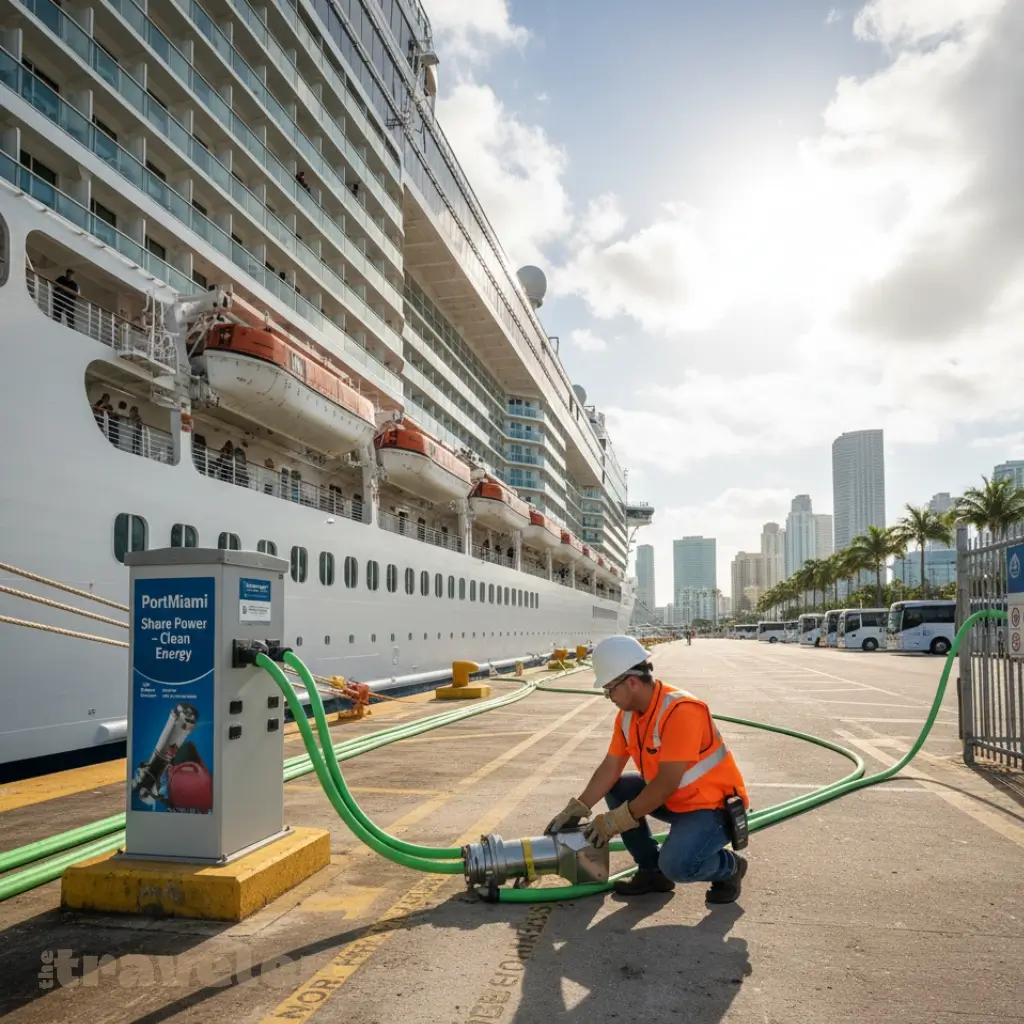
The rapid growth of cruise tourism in Miami has not come without environmental debates and concerns. Critics and environmental advocates point out that cruise ships, by their very nature, pose challenges to local ecosystems and the climate. These massive vessels burn significant quantities of fuel and have historically emitted large volumes of air pollutants and greenhouse gases.
A single cruise ship’s engines can produce substantial exhaust while in port and at sea, contributing to air quality issues. Additionally, cruise ships generate significant waste – from garbage and sewage to wastewater – raising concerns about how this waste is managed and its impact on the marine environment. In South Florida, there have been worries about ships dumping or discharging waste (even treated wastewater) potentially affecting the fragile coral reefs and water quality of Biscayne Bay.
The influx of passengers itself can strain local resources: thousands of cruise visitors concentrate in certain areas, which can impact water usage, traffic, and even sewage systems on heavy days. These issues form the crux of the environmental debates surrounding Miami’s cruise tourism boom – how to balance economic benefits with the need to protect the environment that both residents and visitors value.
In response to these concerns, both the cruise industry and Miami authorities have begun implementing sustainability measures. One landmark step has been the introduction of shore power at PortMiami. In June 2024, PortMiami launched a new shore power system that allows cruise ships to plug into the local electrical grid while docked, rather than keep their diesel engines running.
By shutting off their engines in port, ships dramatically cut emissions of air pollutants and greenhouse gases during their stay, as well as reduce noise and vibration. Miami is the first major cruise port on the U.S. East Coast to offer such extensive shore power capability, outfitting multiple berths for this cleaner technology. Cruise lines themselves are also investing in greener practices.
Many new ships calling Miami are built with cleaner propulsion systems – for instance, some are capable of using liquefied natural gas (LNG) or have advanced emissions scrubbers – and companies are experimenting with cleaner fuels and energy-efficient designs. Waste management on board has improved as well: cruise lines have policies to reduce single-use plastics, increase recycling, and properly treat wastewater to higher standards before discharge.
Beyond technical fixes, the industry has taken up community and environmental initiatives in South Florida, such as supporting beach clean-ups, mangrove restoration projects, and contributing to local environmental charities. These efforts indicate a shift towards a more sustainable model of cruising, though many environmentalists argue there is still a long way to go. The conversation in Miami continues to be a balancing act – celebrating the economic gains of cruise tourism while also pushing for stronger environmental stewardship to ensure the bay and skies remain as beautiful as the cruise ads promise.
Cruise Tourism as Part of Miami Global Image
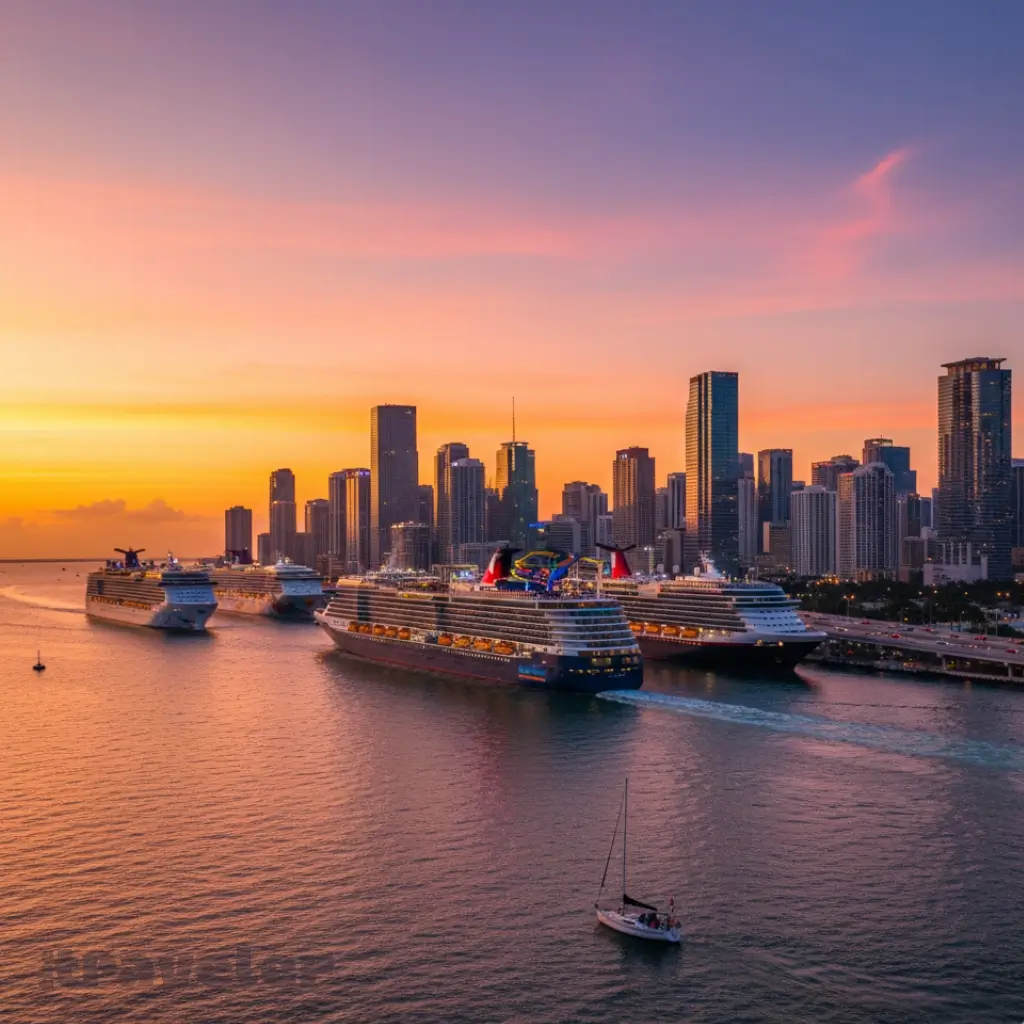
Cruise tourism isn’t just an economic force in Miami – it’s a core part of the city’s global image and identity. For millions of travelers around the world, Miami is synonymous with cruising. Images of Miami’s downtown skyline with cruise ships in the foreground are iconic in travel brochures and social media, instantly recognizable as the starting point for tropical adventures.
The constant parade of massive cruise liners has even become a distinct feature of Miami’s skyline. Local leaders note that the rise of PortMiami has literally changed the city’s landscape – the sight of cruise ships and their striking terminals is now an indelible part of Miami’s panorama.
Modern architectural marvels like Royal Caribbean’s Terminal A (shaped like a crown) and Norwegian’s Pearl of Miami terminal not only serve practical needs but also stand as new landmarks. This blending of city and cruise port visually underscores how intertwined Miami and cruising have become.
Miami’s international reputation as the world’s cruise capital also bolsters its brand as a cosmopolitan, welcoming city. Each year, the city hosts cruise passengers from across the globe, reinforcing Miami’s status as a gateway to the Americas. Tourists from North America, Europe, Latin America, and Asia all converge here to begin voyages – often experiencing Miami’s multicultural flavor before or after their cruises.
The cruise industry’s presence contributes to that cosmopolitan vibe: one can hear a mix of languages in Miami’s cruise terminals and airport on embarkation days, from Spanish and Portuguese to German, French, and Chinese, as travelers arrive to set sail. Additionally, being home to the headquarters of major cruise corporations has put Miami on the map in the business world. Industry conventions and cruise trade shows frequently take place in Miami, drawing global attention to the city’s role in tourism and travel innovation.
Finally, Miami’s ability to attract the biggest and best in cruising has become a point of pride that feeds its global image. When Royal Caribbean unveiled the Icon of the Seas – currently the largest cruise ship in the world – it was no surprise that this record-breaking ship would call Miami home. The deployment of such headline-grabbing vessels to PortMiami sends a message that Miami is the place for cutting-edge cruise experiences.
Likewise, new cruise brands often debut in Miami to tap into its enormous cruise market. All of this reinforces a virtuous cycle: Miami’s name is practically interchangeable with cruising in the public imagination, which in turn draws even more cruise business to its port. From tourism marketing that proudly touts Miami’s Cruise Capital nickname to the countless postcards and Instagram shots of ships departing past South Beach, cruise tourism is now woven into Miami’s identity.
It has helped shape how the world sees Miami – not just as a city of beaches and nightlife, but as an international gateway to adventure on the high seas. In sum, the growth of cruise tourism has not only bolstered Miami’s economy; it has elevated the city’s profile worldwide, anchoring Miami’s status as a truly global city built on the allure of the open ocean.
FAQ
Why is Miami called the “Cruise Capital of the World”?
It handles more cruise passengers than any other port globally.
How many cruise passengers passed through PortMiami in 2024?
A record 8.23 million, up 12.8% from 2023.
What’s the economic impact of cruise tourism?
$61 billion annually to Miami’s economy, supporting 340,000+ jobs in South Florida.
What are the environmental concerns?
Air pollution, waste management, and pressure on Biscayne Bay’s ecosystems.
What steps are being taken for sustainability?
PortMiami launched shore power in 2024, and cruise lines are investing in LNG ships, emission controls, and waste reduction.
